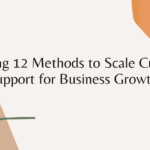In today’s highly competitive business landscape, customer success has become a vital aspect of any company’s growth strategy. It focuses on nurturing strong, long-term relationships with customers by ensuring their satisfaction and success with the product or service. However, achieving customer success isn’t without its hurdles. In this blog, we will delve into the ten biggest challenges faced by customer success teams and present effective solutions to overcome them. By addressing these challenges head-on, you can elevate your customer success efforts and foster loyalty, retention, and advocacy among your customer base.
1. Understanding Customer Needs and Expectations:
Challenge:
The first step towards successful customer success lies in understanding what your customers truly need and expect from your product or service.
Solution:
Conduct in-depth customer research and gather feedback regularly. Use customer surveys, interviews, and analytical tools to gain insights into their pain points, expectations, and desires. This information will help you tailor your offerings and improve customer satisfaction.
2. Onboarding and Training:
Challenge:
The onboarding process is crucial for new customers to familiarize themselves with your product and its features. Inadequate onboarding can lead to confusion and early churn.
Solution:
Develop a comprehensive onboarding program that guides customers through the setup process and showcases the value of your product. Offer personalized training sessions and provide accessible resources like video tutorials and knowledge bases.
3. Proactive Customer Engagement:
Challenge:
Waiting for customers to reach out with concerns or issues can lead to dissatisfaction and missed opportunities.
Solution:
Initiate proactive communication by implementing regular check-ins, milestone celebrations, and product updates. Use customer success platforms to track engagement metrics and identify potential problem areas before they escalate.
4. Managing Customer Expectations:
Challenge:
Misaligned expectations can result in unhappy customers who feel misled or dissatisfied with the product’s performance.
Solution:
Set clear and realistic expectations during the sales process and throughout the customer journey. Be transparent about what your product can and cannot do. Provide accurate documentation and manage expectations effectively to build trust.
5. Handling Customer Complaints:
Challenge:
Customer success teams must be adept at resolving complaints and issues promptly to maintain customer satisfaction.
Solution:
Train your customer success representatives in active listening and effective problem-solving techniques. Empower them to take ownership of customer issues and escalate when necessary. Respond to complaints with empathy and provide timely solutions.
6. Upselling and Cross-Selling:
Challenge:
Successfully upselling and cross-selling to existing customers can significantly impact revenue, but it must be done tactfully to avoid being seen as pushy.
Solution:
Recommend additional products or upgrades based on customers’ needs and usage patterns. Provide valuable insights and incentives for upgrading. Focus on adding value rather than pushing sales.
7. Customer Churn:
Challenge:
Customer churn can have a detrimental effect on your business’s growth and sustainability.
Solution:
Implement a robust churn analysis process to identify potential churn triggers. Engage at-risk customers with personalized offers, dedicated support, or enhanced features. Use customer feedback to continuously improve your product and service.
8. Team Collaboration:
Challenge:
Effective customer success requires seamless collaboration between sales, marketing, and support teams.
Solution:
Foster open communication channels between departments, hold regular cross-functional meetings, and utilize collaborative tools. Encourage team members to share insights and feedback to improve the overall customer experience.
9. Scaling Customer Success:
Challenge:
As your customer base grows, it becomes increasingly challenging to maintain personalized customer success efforts.
Solution:
Invest in customer success automation tools and workflows to streamline processes while maintaining a personal touch. Leverage data analytics to identify trends and segment customers for targeted outreach.
10. Measuring Customer Success Metrics:
Challenge:
Without a proper understanding of key customer success metrics, it’s challenging to track the effectiveness of your strategies.
Solution:
Define relevant KPIs such as customer satisfaction score (CSAT), Net Promoter Score (NPS), and customer retention rate. Utilize data-driven insights to continually optimize your customer success approach.
Recommended reading :
Frequently Asked Questions
1. What is the biggest challenge as a Customer Success Manager?
As a Customer Success Manager, one of the most significant challenges is striking the right balance between meeting customer expectations and aligning them with the capabilities of the product or service. Understanding and managing customer expectations while ensuring their success can be demanding, as it involves proactive communication, personalized support, and the ability to address any potential issues effectively. It requires strong empathy, problem-solving skills, and deep knowledge of the product to ensure customers achieve their desired outcomes without feeling overwhelmed or disappointed.
2. What are the top 3-5 priorities in customer success?
The top priorities in customer success revolve around maximizing customer satisfaction, retention, and overall business growth. Here are the top 5 priorities:
a. Onboarding and Adoption:
Ensuring smooth onboarding experiences and helping customers adopt and integrate the product into their workflows effectively. This lays the foundation for a successful long-term relationship.
b. Proactive Engagement:
Engaging with customers regularly through check-ins, product updates, and personalized outreach to understand their needs and offer assistance before issues arise.
c. Customer Health Monitoring:
Monitoring customer health and identifying potential risks or opportunities for growth. This involves analyzing usage data, feedback, and customer behavior to take timely actions.
d. Value Demonstration:
Continuously demonstrating the value of the product to customers and showcasing how it aligns with their specific goals and objectives. This helps strengthen customer loyalty and advocacy.
e. Churn Reduction:
Focusing on churn reduction by identifying churn triggers, addressing customer concerns, and providing solutions that align with their evolving needs.
3. What are the top 5-10 metrics that the Customer Success team at Plum should measure?
The Customer Success team at Plum should focus on measuring key performance indicators (KPIs) that align with their objectives of customer satisfaction, retention, and growth. Here are the top 10 metrics:
1. Customer Satisfaction Score (CSAT):
Assessing customer satisfaction with the product and overall experience through post-interaction surveys or feedback requests.
2. Net Promoter Score (NPS):
Measuring customer loyalty and their likelihood to recommend the product to others, providing insights into customer advocacy.
3. Customer Retention Rate:
Calculating the percentage of customers who continue to use the product over a specific period, indicating customer loyalty.
4. Expansion Revenue:
Tracking revenue generated from upsells, cross-sells, and renewals, highlighting the success of customer expansion efforts.
5. Time to Value:
Measuring the time it takes for customers to achieve their desired outcomes and experience the full value of the product.
6. Churn Rate:
Calculating the percentage of customers who cancel their subscriptions or stop using the product within a specific period.
7. Customer Lifetime Value (CLV):
Evaluating the total revenue generated from a customer over their entire relationship with the company, indicating the profitability of customer segments.
8. Product Adoption Rate:
Assessing how quickly customers adopt and use specific features or functionalities of the product.
9. Customer Effort Score (CES):
Measuring the ease of doing business with the company and how much effort customers need to invest in achieving their goals.
10. Customer Health Score:
An overall assessment of customer health, incorporating various qualitative and quantitative factors to predict potential churn or growth opportunities.
By measuring these metrics, the Customer Success team at Plum can gain valuable insights into their customers’ experiences, identify areas for improvement, and make data-driven decisions to enhance overall customer success and satisfaction.
Further reading :
Conclusion:
Customer success is the backbone of a thriving business. By recognizing and addressing the ten biggest challenges outlined in this blog, you can build stronger customer relationships, increase retention rates, and drive overall business growth. Embrace these solutions and fine-tune your customer success strategy to exceed customer expectations and stay ahead of the competition. Remember, a successful customer is a loyal customer, and customer success is an investment that pays dividends in the long run.





